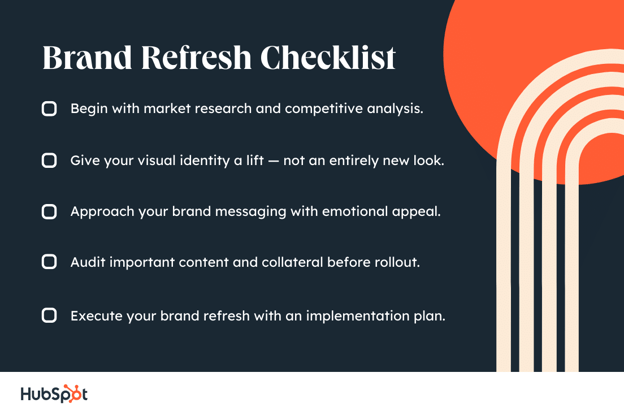Brands that aren’t constantly evolving run the risk of becoming outdated or irrelevant. Some of the most popular brands of today would not have made waves unless they had undergone rebrands or refreshes.

For example, Apple is an excellent example of successful rebranding. In the early 1990s, Apple was slowly dropping out of the computer market. Apple updated its iconic logo from the dated rainbow to a sleeker, monochrome look to signal the change in its brand image. Of course, that wasn’t the only change, but it did mark the beginning of a new era for Apple. Today, they're one of the most widely recognized brands in the world.
So, what’s the right solution for your client? In this post, we’ll discuss what exactly it means to rebrand or refresh your business strategically and stand the test of time.
What is a brand refresh?
A brand refresh is a strategic set of changes made to a brand's identity to realign with current marketplace trends.
It’s more of a risk for a business to remain stagnant than to attempt to change in any developing market. With business trends coming and going, businesses looking to refresh their identity would change elements such as:
- Logo
- Font
- Color Palette
- Brand Slogan
- Writing Style
But sometimes, it takes much more than just updating a logo or font, some businesses may need to make core changes to avoid the risk of losing competitive edge — by conducting a rebrand.
Brand Refresh vs Rebrand
A brand refresh is when a brand attempts to modernize its image while maintaining its core identity and strategy. A rebrand is a complete overhaul of the brand's identity and strategy, typically enacted when the current brand strategy fails.
Think of rebranding as a series of substantial changes made to breathe life back into a struggling company. This process is more in-depth and can change elements of business including:
- Brand Positioning
- Brand Values
- Brand Guidelines
- Mission and Vision Statements
These can be time-consuming, expensive, and need a lot of approval to conduct, so if you’re looking to make more immediate changes for businesses, let’s dive into brand refresh strategy.
Brand Refresh Strategy
Use the steps below to guide your client through a successful refresh — but encourage them to adjust each step to fit the needs and audience of their company.
1. Determine if you need a brand refresh or a rebrand.
Perhaps your client has verbalized her desire to rebrand, but you should figure out its purpose before you even jump straight into rebranding. You should consider other avenues if your client can't present a concrete reason (and “I’m bored” doesn’t count).
Why do you need to do this first? Rebranding isn’t as simple as slapping on a new logo or changing your name. Companies have to be willing to change their entire company vision, including company goals, message, and culture.
It takes a lot of time, money, and effort to pull a rebrand off successfully, and those that aren’t fully committed will be stuck with a poorly defined brand that will not stand out in today’s competitive market.
So how do you know if you should encourage your client to take that giant leap to rebrand? Here are some great cues:
- The brand has plans to expand the company nationally or internationally.
- Its current brand is restricting its growth into other markets.
- Its customers have negative associations with the company.
- The company is merging or acquiring other companies.
If that’s the case, refer to our guide to a successful rebrand to better serve their needs. And if there’s not a pressing need that necessitates a rebrand, move forward with conducting a refresh.
2. Brainstorm with your team to envision what they want the company to become.
The responsibility of a brand’s refresh shouldn’t fall on the shoulders of the few but instead should include your team to come up with new ideas for the brand’s future. You’ll have to decide which elements can have the opportunity to attract more attention.
- Logo: Modernize your logo to be more unique and stand out against competitors.
- Font: Make your chosen font accessible, professional, and distinct.
- Color Palette: Let your color palette speak for your brand with color theory.
- Brand Slogan: Refreshed brand slogans should speak to relevant needs.
- Writing Style: Tailor your writing style to be more consistent and speak to the buyer personas looking for the company’s product or service.
And if you’re working on a business for a client, ask them and their team questions like:
- Do they plan on growing to a national or international level?
- What other markets do they want to expand into?
Incorporate their answers into their brand image so a future refresh won’t be necessary.
3. Use social media to communicate with your audience.
Soft launch your refresh with updated collateral or UI/UX. For today’s business owners, using sites like LinkedIn, Twitter and Facebook are among the most popular to reach target audiences.
Use social media marketing to inform your audience of the upcoming changes and informally poll them about their thoughts on the refresh. You can gather research this way by engaging in social listening and taking your audience’s feedback into consideration and including them in your new look.
4. Consider your audience’s emotions or desires in your strategy.
The most successful brands evoke some kind of emotion from their target audience. Go out and meet them; speak to them directly and get feedback; see how you can improve your image. People want to feel they're making a difference, and doing that face-to-face, or incentivized through surveys, are great ways to increase customer loyalty.
5. Implement the changes slowly.
Start with something small, like changing the font used on documents, and work from there. Gauge reactions, and adjust when possible. If there is too much negative feedback, approach your audience to understand the issue and see if changing some things will affect your rebranding or not.
So if you’re ready to take the next step and conduct a brand refresh, you could benefit from a checklist to make sure you conduct your own brand refresh with intention.
Brand Refresh Checklist

Begin with market research and competitive analysis.
Base your refresh on changes you’ve seen in the market. This can include discovery and research either conducted internally or through third parties and should consider shifts in customer needs and external factors like the economy and other trending news.
Competitive analysis will also allow you to gain inspiration from the successes and failures of your competitors as they try to maintain relevance, too.
Give your visual identity a lift — not an entirely new look.
Whether it's your logo, slogan, or color palette, you want to remain recognizable in a refresh. If it’s currently outdated, muted, or busy, try making it more visually appealing with more exciting color, geometry, or a sleek font choice.
Approach your brand messaging with emotional appeal.
Your messaging should be made for your buyer personas and demonstrate value in terms of content quality and emotion. A successful refresh with sincere, trustworthy messaging will reflect the emotional intelligence of your company, and set it apart from competitors.
Audit important content and collateral before rollout.
When planning to conduct your refresh, a task you shouldn’t forget about is running a content audit. More often than not, getting rid of or editing your pre-existing posts, website, or other brand elements can already give your digital footprint a facelift.
Execute your brand refresh with an implementation plan.
After your team has decided what all is to be changed in the brand refresh, the implementation of these changes will have to be properly communicated and acted upon internally and externally with a proper implementation plan.
Keep Your Brand Identity Fresh
A successful company is an overall goal for your team. And with a well-executed rebrand or refresh, you can position your brand to stand the test of time. Change is good, and while it may take time to see the results, your brand’s adaptability will be rewarded.
Editor’s note: This article was originally published in September 2014 and has been updated for comprehensiveness.
![Free Download: How to Create a Style Guide [+ Free Templates]](https://no-cache.hubspot.com/cta/default/53/76520ae5-1a3b-4055-9e8e-95e150b90965.png)




